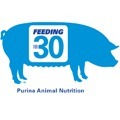 Gilts represent the future of the sow herd and close to 25 percent of the U.S. swine population; however, the importance of gilt development to the sow’s lifetime contribution in the herd is often underestimated. Because gilts represent the newest genetic pool, focusing on gilt nutrition and development can help producers move forward quickly.
Gilts represent the future of the sow herd and close to 25 percent of the U.S. swine population; however, the importance of gilt development to the sow’s lifetime contribution in the herd is often underestimated. Because gilts represent the newest genetic pool, focusing on gilt nutrition and development can help producers move forward quickly.
Gilt development begins after pigs exit the nursery. Industry data suggests that gilts should be fed for production once they reach 150 to 180 pounds. Field demonstrations in both the United States and Spain suggest that swine producers need to begin gilt development for replacement gilts at an even earlier age than these currently set standards. Starting these females out on the right nutrients and correct growth rate level is important to maximize their lifetime potential and longevity within the herd.

“Gilt retention rates can be improved by up to 50 percent within the sow herd by implementing some simple changes, such as providing larger pen space per pig, utilizing better flooring and feeding a balanced diet – one that includes zinc, manganese and copper as amino acid complexes,” says Mark Wilson, Ph.D., reproductive physiologist at Zinpro Corporation.
Without adequate space, environments and nutrition, gilts can have a greater potential for lameness. Structural issues on gilts’ feet and legs can put the individual at a disadvantage from the start with lower reproductive rates, decreased feed consumption and depressed joint, muscle and skeletal development. In fact, lameness accounts for an estimated 15 percent of total culls through first parity.
One of the keys to helping gilts develop structurally is improved nutrition. Addressing the growing gilt’s nutritional needs not only decreases feed costs – which account for 70 percent of a replacement gilt’s cost – but also contributes to her longevity in the herd.
Wilson encourages producers to start developing their replacement gilts as early as 40 pounds in order to maximize lifetime potential and longevity in the herd. By slightly slowing her growth rate and feeding correct levels of essential nutrients, she is able to reach this physiological maturity level at 230 days and 300 pounds of body weight with an improved skeletal structure-to-weight balance.
Bringing mature, structurally sound gilts into the herd improves their chances of reaching their fourth parity – the point at which they begin making money for the swine operation. In fact, data shows that increasing the number of sows in parity 3 through 6 has a significant impact on the overall productivity of the herd.
The weight of the gilt at breeding time can be a contributing factor to lifetime productivity as well. Research has shown that by breeding gilts at 300 to 310 pounds body weight on their second or third estrus, the gilt has the weight and maturity to gestate and support a litter of pigs and is much easier to re-breed after the first litter. Gilts bred at less than 300 pounds had fewer total pigs over three parities than their heavier, more mature counterparts as shown by several different genetic groups.
“Nutrition plays an essential role in gilt development programs to help prepare young sows to meet the challenges of their first parity,” Wilson says. “Ultimately, this sets the stage for improved animal performance and sow longevity.
January 14, 2014 - Feeding for 30


